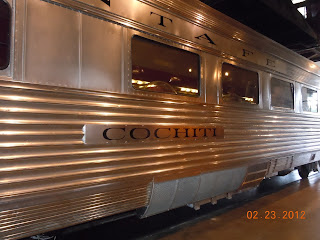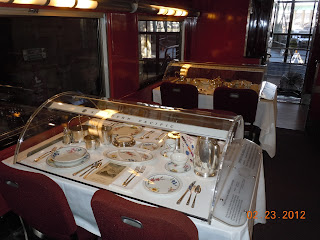 |
| AT& SF Ding Car"Cochiti" |
In the course of thirty years or less, railroad dining cars appeared on the western frontier. Thirty years is not a necessarily a short time frame but the changes that occurred in the American West was absolutely astounding. The years between 1850 and 1900 saw some of the most dramatic changes in railroad travel and particularly travel in the western United States. One of those changes was the introduction of the dining car. In modern times today there are many who enjoy railroad dining which is why you have the opportunity to ride the several dinner trains offered around the U.S. It's a way to experience a piece of American history from the days of great national expansion.
The Atchison, Topeka and Santa Fe Railroad
The story of the Atchison Topeka & Santa Fe Railroad had a lot to do with a man named Fred Harvey and eventually with lavish dining car service. Many history books will tell you that the AT& SF Railroad was considered the blue-chip of all the nation's railroads. This route truly offered scenic train rides.The railroad to the country's southwest utilized the expertise of Fred Harvey to establish hotels and dining rooms along it's route. During the 1870's, eating establishments along rail routes had a deservedly bad reputation. This applied to both the food itself and the surroundings. As many people know, Fred Harvey changed that and the Atchison Topeka & Santa Fe benefited greatly. In fact, many people were known to opt for the dining car fare rather than eat at a railroad station.
 |
| Sample of china and silverware in dining car |
Santa Fe and Fred Harvey first became associated together in 1876 with a Harvey Lunchroom. This expanded to Harvey resort hotels after the turn of the 20th century. The dining car service on the AT& SF Railroad was long and successful and culminated in the lightweight extra-fare Super Chief of 1937 which is shown in the photos in this article.
Fred Harvey Manages the At & SF Dining Cars
Fred Harvey was so successful in managing the rail side eateries that the railroad asked him to put his magic to work on their planned dining cars. To Harvey, this was not ideal. Harvey initially didn't feel that the same level of quality could be served up on a moving train car.
Since the 1880's, dining cars became standard offerings on cross country trains heading west from Chicago. The AT& SF relied on the string of Harvey Houses along it's route. In fact, these Harvey Houses were strategically located to accommodate passengers during meal hours.
To put this in some perspective, railroads without the Fred Harvey eateries along the way put their passengers through quite an ordeal. At a stop, railroad passengers might have had up to one hour to find the nearest roadhouse to the train tracks and hope for the best. Unfortunately, the best sometimes wasn't all that good. This very fact is what gave Fred Harvey his early inspiration. The Fred Harvey customers usually were aware of one trademark of the Harvey dining rooms. Harvey's meals were served in sumptuous portions that provided a good value for the traveling public. All of a sudden railroad dining reached a new higher level. This and quality and the AT& SF scenic train trips was a winning combination.
Regarding the dining cars, Fred Harvey's quality food and service was first introduced on the California Limited, one of the great rail excursions. Later, the first class Super Chief also included dining cars staffed by Fred Harvey employees. The dining cars were quite lavish in decor with tablecloths and food served on fine china. Not only could passengers on the AT& SF Railroad enjoy the splendid southwest scenery while dining but they could also count on the legendary Fred Harvey quality.
Fred Harvey's efficiency on the dining cars was such that a Harvey dining car was known to be able to serve an entire train load of passengers in thirty minutes. This was quite remarkable considering the level of service offered. Railroad dining cars were not something found only on the AT& SF but what this railroad successfully marketed was the Fred Harvey reputation. With the great reviews his Harvey Houses had attained, marketing the AT& SF dining cars was not difficult. With so many railroads competing during the years of the late 1800's, something that would set one railroad apart from the other was a good management move.
There's a very good book available, The Harvey House Cookbook by George H. Foster that includes vintage recipes from the various Harvey Houses and the railway cars. The book includes over 200 recipes.
You should find the following two articles of special interest relating to the early railroads and Fred Harvey.
How the Pullman Sleeper Coach Improved Rail Travel and the story of Fred Harvey and the Grand Canyon's El Tovar Hotel.
The Cochiti Dining Car
 |
| "Cochiti" Dining Car Kitchen |
This rail car was a new streamlined stainless steel car that was part of the railroad's famous "Super Chief" train that offered once a week service between Chicago Illinois and Los Angeles California.
The car and seven others were ordered by the railroad in 1936. All of the AT&SF cars were named after Native Indian tribes. The Cochiti was named after the Indian pueblo of Cochiti about thirty miles southwest of Santa Fe New Mexico.
The Cochiti dining car has been preserved and is on display at the famous California State Railroad Museum located in Old Town Sacramento California. The museum has done a great job in displaying this historic rail car. When you walk through the car you can see the kitchen area and all the table have been set with china and silverware. This is one of the most authentic rail car displays I've visited. This particular dining car has been set to it's mid 1940's condition.
Railroad dining cars today are quite different than the earlier cars in basic design. The Cochiti dining car was a one level rail car where the kitchen area was on one end of the car with the dining tables occupying the remainder. You might have a kitchen area with bar stools and then the table beyond. On today's Amtrak bi-level rail cars, you have the dining booths taking up most of the upper level with the kitchen area being on the lower level. Food is sent up via a dumbwaiter.
 |
| AT& SF dining car table settings |
When you look back at the early days of railroading, it's interesting to explore the combination of the Atchison Topeka & Santa Fe Railroad and Fred Harvey. The AT& SF was certainly looked upon as being the nation's blue-chip railroad. Exactly how much of that reputation was attributed to Fred Harvey's efforts and how much to the railroad directors themselves should be credited is an interesting study.
Today, the route of the Atchison Topeka & Santa Fe Railroad can be experienced by traveling on the Amtrak Southwest Chief. While the dining cars are of course a bit different, you can still enjoy the wonderful southwest scenery that makes a trip like this a special train excursion. The Southwest Chief travels daily between Chicago and Los Angeles in both directions.It is one of the most scenic trains of all the Amtrak routes. Another interesting article you'll find interesting is a trip on Amtrak's popular Coast Starlight.
Some Great Places to Visit
 |
| Amtrak's Southwest Chief |
The Harvey family home located in Leavenworth Kansas is now owned by the Leavenworth Historical Museum and is now operated as the Fred Harvey Museum. Fred Harvey originally purchased the home in 1883. For a very unique stop on your vacation trip planner, in Florence Kansas, the very first Harvey House Hotel called the Clifton House and built in 1878, is now a museum and restaurant. The restaurant features Harvey girl waitresses, tour guides and vintage recipes.
(Article and photos copyright 2013 Western Trips)


